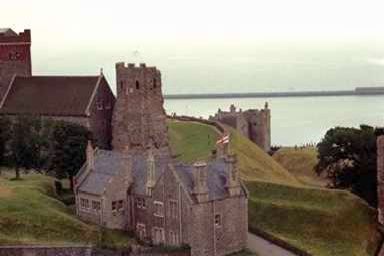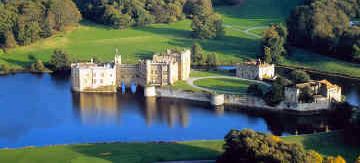
Castles of England
| Категория реферата: Топики по английскому языку
| Теги реферата: скачать контрольные работы, курсовая работа производство
| Добавил(а) на сайт: Якимычев.
1 2 3 | Следующая страница реферата
Castles of England
Introduction to castles
Britain is strewn with ruins of castles, rubble from the centuries of her existence. Castles are tangible relics of a remarkable past, a lengthy heritage etched in stone, as well as with the blood and sweat of those who built, labored, fought, and died in their shadow. Ruins stir up in us a profound awareness of those past lives. Castles have a timelessness that is awe-inspiring. That they have endured centuries of warfare and the effects of weather is a testimony to the creativity and power of their medieval owners. How many of us will have such long-lasting success?
As with gardens castles have had innumerable books written about them quoting design, styles, ages and so on. I think that one or two notes are helpful in distinguishing the various types and the logical development.
The castles that we use as our standard are those built between the 11th and 16th centuries in Great Britain and Northern Europe. The English castle whose design was imported from Normandy following the Norman invasion of 1066 was essentially defensive. The Normans had to hold down a belligerent conquered people and their way was to build a network of castles. William the Conqueror has a ring established around London, including Rochester, Windsor and Berkampstead. These in conjunction with the Tower of London - the White Tower then - acted as a screen around the capital.
As it was said these castles were essentially defensive, designed to protect the Norman families who were granted the land by William. They originally consisted of a mound of earth thrown up with a tower or 'keep' on top, possibly surrounded by a palisade around the bottom and in turn frequently surrounded by a moat. The palisade contained the bailey. The keep was not living quarters normally but a last line of defense in case of attack and the main living area was the bailey where the Lord had a comfortable hall and where there were houses for his soldiers and retainers and their families, stables for the animals as well as the various necessary service buildings, blacksmith, farrier, armourer, etc. In the case of sustained attack the whole countryside include villagers and their beasts could be taken into the bailey for protection and in dire necessity the whole would be withdrawn into the keep.
Originally because of the urgency needed to get them erected these structures were of wood but, as they were vulnerable to fire, quite soon the King insisted that they be built of stone. One of the first of these was the White Tower in the center of the Tower of London. These more substantial buildings soon became home to the Lord and his retainers. It is an axiom of military design that each improvement in design creates its own destruction as the attacker soon learns to overcome the latest technology. Thus castle building became a never ending program of updating to create defensive protection. The keep had its own curtain wall with watchtowers. These were originally built square but it was soon found that it was easy for an attacker to use the square shape to protect himself against defenders and also undermine the corners of the tower. A corner would be undermined and the whole area filled with wooden props to support it. Then pigskins filled with oil and fat would be placed in the cavity and ignited. As the flames destroyed the props so the tower crumbled. An example of this can be seen at Rochester where the undermining of one square corner tower is quite clear before it was rebuilt as round tower.
Castle building grew apace and it became necessary to protect the original curtain wall with its own wall culminating in castles like the Tower of London where there are several concentric rings. England became more settled and by the middle of the fifteenth century in Southern and Middle England except for the King and powerful barons the smaller landowner had found that a more peaceful country made the castle unnecessary. He had had found the castle drafty, cold and uncomfortable and created 'fortified manor house'. This still had strong walls for defense but also had larger windows and more doors while the interior was of wood, rather than stone, to make the whole warmer and a less confrontational design. From then on we get the development of the 'stately home' and palace without any defensive capabilities and from these in turn produced the great Tudor mansions of which Hatfield House and Penshurst Place are typical and in which defense has no part. Peace was now assumed and the history of English castle building reached its end.
In the north of England it was not so easy and until the reign of Henry VIII there were still border attacks. The castles remained strong and well defended until well into the sixteenth century. Thus for hundreds of years the Duke of Northumberland remained influential as much because of the soldiers he could muster as his personality.
CASTLES OF ENGLAND
Dover

Location: Kent
When William the Conqueror defeated Harold II at Hastings he headed towards Dover where the Angle-Saxons had already raised a burh. William improved this fortification by erecting a motte-and-bailey. Dover Castle has the most massive tower in Britain, an almost 100-foot cube with walls from seventeen to twenty-one feet thick. In 1216 the castle was besieged by Louis, son of the French king but saved when Louis returned to France.
Overlooking Dover Harbour, the shortest sea-route to the Continent it barred the way of anybody trying to invade England. Early in the 19th century Napoleon stood opposite on the cliffs of Calais and through his telescope surveyed Dover. With the British navy controlling the seas and the steep cliffs beneath the castle he decided against an invasion of England, immediately turned round and invaded Russia instead. Hitler followed the same pattern and again after contemplating the problem decided to invade Russia instead. Beneath the castle are the secret wartime passages where the evacuation of Dunkirk and the Channel sea battle was controlled.
Warwick Castle

Location: Warwick Country
Warwick Castle was founded in 1068 and was rebuilt and updated a number of times. Today it combines castle ruins, largely of the fourteenth century with one of the finest great houses in England. Two small projecting towers, which date to the late fifteenth century are said to have built as artillery platforms. Warwick Castle rises like a precipice above the River Avon. On this natural cliff William I founded a motte castle in 1068, on lands seized from a nearby Saxon convent. A wooden tower built on the motte was evidently still there in the reign of Henry II, by which time a polygonal shell enclosure had been raised round the motte top. Only fragments of the shell enclosure now remain, incorporated in the rebuilt shell, which is of much later date.
Late in the fourteenth century, by which time some additional buildings such as the great hall and residential blocks had been put up in the bailey, the castle passed to Earl Beauchamp who initiated a fresh programme of works. These were substantially what can be seen today. They included restructuring the great hall and a range of other buildings on the south-east, a water-gate, and on the west front a high and stout defensive curtain leading from a gatehouse to a very tall polygonal tower, known as Guy's Tower, which is 39.4 metres tall. The gatehouse is a remarkable building: a pair of towers above the doorway passage, which had portcullises and murder-holes. Projecting from the east side of the gatehouse is a tall rectangular building leading to another tower.
This latter tower is 45.2 meters tall and capped by a two-fold system of battlements with machicolation all round below the battlements. It is called Caesar's Tower. The three main storeys in the tower are each vaulted, and have stone fireplaces.
The castle is completed by curtain walling and further, much smaller, flanking towers. The wall at the west leads up the motte to the restored shell enclosure and down again southwards to the south range. The whole is thus a powerfully defended enclosure
Leeds Castle

Location: Kent
Leeds Castle, acclaimed as the most romantic castle in England, is located in south-east England, built on two adjacent island in the river Len.
Leeds Castle was originally a manor of the Saxon royal family possibly as early as the reign of Ethelbert IV ( 856-860). The first castle was an earthwork enclosure whose wooden palisade was converted to stone and provided with two towers along the perimeter. This is now vanished. Traces of arches in a vault thought to be Norman were found at the beginning of this century.
Рекомендуем скачать другие рефераты по теме: курсовые рефераты, сочинение бульба, bestreferat.
Категории:
1 2 3 | Следующая страница реферата
 Главная
Главная